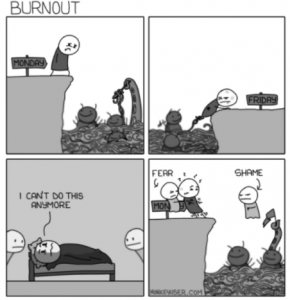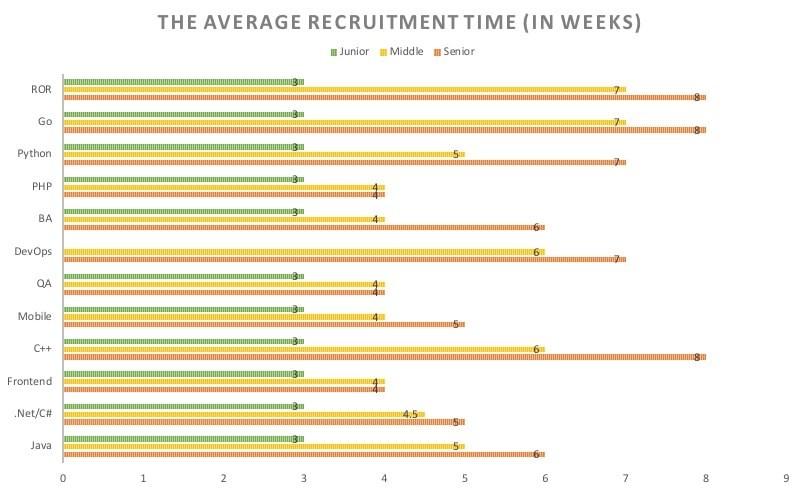
Inhalt:
- Was ist “Entwickler-Burnout”?
- Ursachen, Symptome und Phasen des Burnouts
- Wege zur Vermeidung von Entwickler-Burnout
- Die Motivation der Entwickler: Was können Unternehmen tun?
- Motivationsrezept für Legacy-Projekte
Einleitung
Softwareentwickler sind keine Computer. Sie sind empfindliche menschliche Wesen mit komplexen Emotionen, um die man sich in einer sich schnell verändernden, technologieüberladenen Welt kümmern muss. Heute werden wir herausfinden, ob Technologen glücklich und gesund sind und falls nicht, was man dagegen tun kann.
- Was ist Entwickler-Burnout?
Laut der World Health Organization ist Burnout ein “berufsbedingtes Phänomen”, das von der medizinischen Gemeinschaft weltweit anerkannt wird und durch drei Dimensionen gekennzeichnet ist:
- Gefühle der Energielosigkeit oder Erschöpfung
- Geringere berufliche Effizienz
- Erhöhte mentale Distanz zu einem Arbeitsplatz, Gefühle von Negativismus/Zynikismus in Bezug auf die eigene Position (1)
- Sind Technologen glücklich oder nicht? Ursachen, Symptome und Phasen des Burnouts
Unsere Kollegen haben eine kleine Umfrage mit 350 Befragten durchgeführt. Die Ergebnisse waren interessant: 70% der Entwickler waren glücklich bei der Arbeit, während mehr als 14% unglücklich waren und 15% gleichgültig blieben.
Die Umfrage hat auch gezeigt, dass das Gehalt (60 %), die Work-Life-Balance (58 %), die Flexibilität (52 %), die Produktivität (52 %) und die Aufstiegschancen (49 %) die fünf wichtigsten Gründe für die Zufriedenheit der Entwickler sind. Wusstest du übrigens, dass die glücklichsten Entwickler in Spanien leben (90%)?
Andererseits ist die Unzufriedenheit der Entwickler durch ein niedriges Gehalt, das Fehlen einer gesunden Work-Life-Balance, das Gefühl, bei der Arbeit unproduktiv zu sein, und begrenzte Aufstiegsmöglichkeiten bedingt. (2)

Zwei weitere Umfragen unter britischen und amerikanischen CIOs und IT-Entscheidungsträgern (jeweils fast 600 Befragte) ergaben, dass 83% der Softwareingenieure bei der Arbeit ein Burnout erleben. Die häufigsten Symptome sind:
- Verlust der Leidenschaft
- Körperliche Lethargie/Müdigkeit
- Geistige Erschöpfung
- Veränderte Gewohnheiten
- Sich isoliert/abgekapselt fühlen
- Leistungsprobleme (1)
Das Problem scheint universell zu sein und ist nicht auf eine bestimmte geografische Region, ein Einkommen oder einen Beruf beschränkt. Wissenschaftler untersuchen das Phänomen des Burnouts schon seit Jahrzehnten, falls nicht sogar seit Jahrhunderten (dieser Zustand wurde zuerst im Buch Exodus beschrieben). Herbert Freudenberger, ein amerikanischer Psychologe, beschrieb den Prozess des “burning out” in 12 Phasen, die später zu fünf Phasen vereinfacht wurden:
- Hochphase. Keine Anzeichen von Burnout; die Beschäftigten sind voller Begeisterung, Engagement und Freude an ihrer Arbeit. Sie sind produktiv, kreativ, optimistisch und voller Energie.
- Einsetzen von Stress. Die Menschen bemerken allmählich, dass manche Tage stressiger sind als andere. Zu den ersten Anzeichen gehören Konzentrationsschwierigkeiten, Kopfschmerzen, Angstzustände, veränderter Appetit und sogar hoher Blutdruck.
- Chronischer Stress. Die Leistungs- und Problemlösungsfähigkeit nimmt ab; Menschen zögern; selbst kleine Dinge können sie aggressiv, nachtragend oder traurig machen. Sie greifen möglicherweise zu Alkohol und Drogen.
- Burnout. Das Gefühl der Machtlosigkeit, des Versagens, der Verzweiflung und der Desillusionierung überwiegt. Es kann zu ständiger Müdigkeit, Verdauungsproblemen, chronischen Kopfschmerzen und möglichen Verhaltensänderungen kommen.
- Gewohnheitsmäßiger Burnout. Menschen fühlen sich immer traurig und deprimiert, wenn Burnout zu einem festen Bestandteil ihres Lebens wird. Es ist eine große Herausforderung, wieder zu einem normalen Leben zurückzufinden. (3)

Falls du oder jemand aus deinem unmittelbaren Umfeld von Burnout betroffen ist, ist es wichtig, dass sie oder er so schnell wie möglich in den Alltag zurückkehrt. Denk daran: Ein Gespräch mit deinem Hausarzt oder einer psychosozialen Beratungsstelle ist in jeder Situation der beste Anfang!
- Wege zur Vermeidung von Entwickler-Burnout
Niemand außer dir kann den Prozess des Burnouts, die “Plage des 21. Jahrhunderts”, aufhalten. Um das zu schaffen, musst du einfache Tipps zur Vermeidung von Burnout in jedem beruflichen Bereich kennen. Denk daran: Mit diesen Tipps ist es einfacher, Burnout zu verhindern als zu behandeln:
- Organisiere deinen Arbeitsablauf
- Mische verschiedene Frameworks und Technologien
- Lerne, wann du “Nein” sagen solltest
- Lege im Laufe des Tages regelmäßig Pausen ein
- Mache eine “richtige” Pause: längere Urlaube ohne deinen Computer
- Achte auf dich selbst (1)

Hier sind einige weitere Möglichkeiten, wie du einem Entwickler-Burnout vorbeugen kannst (das gilt auch für jeden anderen Bereich deiner beruflichen Interessen):
- Finde heraus, was deine Leidenschaft für Technik ausmacht
- Beantrage deine Pause
- Vermeide unrealistische Ziele
- Finde einen gesunden Zeitplan
- Priorisiere dein Wohlbefinden
- Wechsle deine Aufgaben ab
- Biete flexible Termine an (4)
- Die Motivation von Entwicklern: Was können Unternehmen tun?
Der Kampf gegen Burnout is zweispurig: Sowohl einzelne Ingenieure als auch Unternehmen sollten “Nein” zu diesem zerstörerischen Phänomen sagen. Hier sind 13 Möglichkeiten, wie psychologisch geschulte Manager die Softwareentwickler in einem Team oder Unternehmen motivieren können:
- Den Mitarbeitern zuhören. Jeder Mensch ist anders: Finde heraus, welche allgemeinen oder speziellen Interessen deine Entwickler ansprechen.
- Nutze neue Technologien. Überarbeite und modernisiere alte Software, denn die Pflege von Code, der vor langer Zeit mit veralteten Technologien erstellt wurde, kann frustrierend sein.
- Schulung. Gib Entwicklern die Möglichkeit, sich angemessen schulen zu lassen, damit sie sich vorbereitet fühlen, bevor sie sich in eine neue Technologie stürzen.
- Anerkennung. Mach ihre harte Arbeit deutlich und lass sie von deinen Kollegen wertschätzen. Dankbarkeit kann zu einer glücklichen Arbeitskraft führen.
- Wachstumschancen. Biete Entwicklern die Möglichkeit, sich zu entwickeln und innerhalb des Unternehmens eine Führungsrolle zu übernehmen.
- Chancen für Innovationen. Ermutige Softwareentwickler dazu, bei Hackathons Spaß zu haben und zu experimentieren.
- Flexible Arbeitszeiten. Vertraue darauf, dass die Entwickler ihre Arbeit zu Zeiten erledigen, zu denen es für sie nicht schwierig ist.
- Flexible Infrastruktur. Führe einen Work-from-anywhere-Ansatz ein, um Mitarbeiter für ihre Fähigkeiten zu würdigen, nicht für ihre physische Anwesenheit im Büro.
- Ermächtigen. Software-Ingenieure sollten die Möglichkeit haben, selbstständig Entscheidungen über ihre Arbeit zu treffen und herauszufinden, wie sie ihre Ziele am besten umsetzen können.
- Vereinfache und rationalisiere. Rationalisiere die Unternehmensprozesse und vereinfache die Werkzeuge, damit sich deine Mitarbeiter auf die wichtigsten Aufgaben konzentrieren können.
- Umgib sie mit Talent. Softwareentwickler blühen in Umgebungen auf, in denen sie von technischen Talenten und beruflichen Herausforderungen umgeben sind.
- Spielen. Entwickler sind große Gamer; Gamification ist ein großes Geschäft. Wenn die Arbeit Spaß macht, werden sich deine Mitarbeiter mehr engagieren.
- Respektiere ihre Intelligenz, ihre technische Begabung, ihren Individualismus und ihre einzigartigen Talente und kümmere dich um sie. (5)
- Motivationsrezept für Entwickler bei Legacy-Projekten
Entwicklern, die an Legacy-Projekten arbeiten, kann es häufiger als dem Rest ihrer Berufsgruppe an Motivation mangeln und zu Burnout kommen. In diesem Abschnitt wollen wir die Ursachen für den Mangel an Motivation ins Rampenlicht stellen und einige mögliche Lösungen aufzeigen (eigentlich ist es das Know-how von Sonerim). Beginnen wir mit einer Metapher aus der Küche.
Jeder liebt gute altmodische Gerichte, sei es ein Eintopf, Pudding oder Omelett. Sie riechen und schmecken nach Omas Küche und lassen dir das Wasser im Munde zusammenlaufen. Sie sind einfach und kunstlos, aber du genießt sie, unvernünftig und unlogisch. Sie sind so lecker und erinnern dich an dein Zuhause…
Du hast sicher den Animationsfilm “Ratatouille” gesehen: Ein altes Rezept, das beibehalten wird, versetzt dich sofort in ein Reich von Glück und Freude. Du kannst die Zutaten nicht ändern; sie sind einfach und wenig; du kannst nur eines tun, um dein Unternehmen erfolgreich zu machen – eine Prise deiner hingebungsvollen Seele hinzufügen.
Legacy-Projekte, vor allem große, schwergewichtige Web-Entwicklungen, sind solchen Gerichten ähnlich. Junge und ehrgeizige Programmierer wollen unbedingt ihre eigene, einzigartige Kodierung erstellen. Sie wollen nicht 90 % ihrer wertvollen Zeit mit der Suche nach der richtigen Stelle in einer monstergroßen Codebasis verschwenden, um einige Zeilen Zusatzcode einzufügen, während nur 10 % für die Einführung neuer Funktionen übrig bleiben. Gleichzeitig möchte ein Kunde sein “Business-as-usual” zu minimalen Kosten beibehalten.
Das ganze System am Laufen zu halten, ist eine Herausforderung! Zum Glück gibt es dieses “magische Rezept”, das aus 3 Zutaten besteht:
- Gleichgewicht
- Zweck
- Ermächtigung zur Entscheidung
Schauen wir uns jede Zutat des magischen Rezepts genauer an:
Gleichgewicht
Ein geschicktes Gleichgewicht zwischen Teamstabilität und anspruchsvollen Aufgaben ist der springende Punkt, wenn du eine Explosion der Projektkosten vermeiden und die Entwickler zufriedenstellen willst. Dein Management muss die Bedürfnisse deiner langfristigen Kunden und deiner Mitarbeiter in Einklang bringen, um für beide Seiten ein verlässlicher Partner zu bleiben.
Dieses Gleichgewicht setzt voraus:
- Eine Portion der laufenden, regelmäßigen Aufgaben (wenn der Kunde die guten alten Zeiten des Projekts beibehalten will);
- Eine Portion der anspruchsvollen Aufgaben, die einen echten Mehrwert in Bezug auf Leistung, Optimierungen und Refactoring-Maßnahmen bringen (wobei die Kunden nicht so gerne in diese Aspekte investieren).
Auf diese Weise angeordnet, werden solche Aufgaben sofort zu einem Puzzle, wenn das ganze Team mit Spaß und Spannung dabei ist, es zu knacken!
Zweck
Die Richtlinie, an die du dich halten musst, ist die folgende: Falls es kein Ziel gibt, erfinde es! Sinnlose, routinemäßige Handlungen oder ein Mangel an globaler Richtung und Vision sind für Entwickler nicht inspirierend und für Projekte nicht förderlich.
Es reicht nicht aus, die Bedürfnisse des Unternehmens zu verstehen. Wir sind so geschaffen, dass wir ein integraler Bestandteil von etwas Größerem und Besserem sein wollen als wir selbst – einem großen Plan, der über die technologische und soziale Entwicklung der Zivilisation hinausgeht. Wir wollen das Gefühl haben, dass wir unseren bescheidenen Teil dazu beitragen, die Welt zu einem besseren Ort zu machen.
Jedes Unternehmen sollte seine Entwickler regelmäßig darüber informieren und ihnen eine detaillierte und motivierende Analyse des Business Case des Kunden sowie der Bedeutung der Pflege von Legacy-Projekten liefern. Es ist notwendig, das Potenzial einer neuen Plattform, ihren großen Umfang und ihren voraussichtlichen Einfluss auf das Geschäft aufzuzeigen.
Ermächtigung zur Entscheidung
Entscheidungen über die eigene Arbeit zu treffen, ist für jeden Fachmann unerlässlich, besonders für einen Software-Ingenieur, der Mitglied einer bestimmten Berufskaste ist. Neben der Einhaltung allgemeiner Richtlinien, die von den Geschäftsführern festgelegt werden, sollte das technische Personal auch mit der Umsetzungstaktik umgehen und über Themen wie Codierungsstandards, Werkzeuge und Designentscheidungen bestimmen.
Jedes Unternehmen sollte erkennen, dass selbstverwaltete Entwicklerteams großartige Partner für die Unternehmensstrategie sind. Sie schlagen den Kunden Änderungen und Verbesserungen vor, halten Präsentationen und bieten Leistungsoptimierung für veraltete Plattformen.
Fazit
Die beste Belohnung für jedes Softwareentwicklungs-Unternehmen sollte sein, dass seine Ingenieure glücklich, gesund und erfolgreich sind. Angenommen, einem Unternehmen gelingt es, die Balance zwischen Stabilität und Innovation sowie zwischen der Gesundheit seiner Mitarbeiter und der Fertigstellung seiner Projekte zu halten. In einem solchen Fall ist es eine unerschöpfliche Energiequelle für weiteres Wachstum, Wohlstand und Nachhaltigkeit. Magisch, nicht wahr?
Quellen:
- https://www.jobsity.com/blog/how-to-spot-and-avoid-burnout-as-a-developer
- https://www.dice.com/career-advice/are-software-developers-actually-happy-in-their-current-jobs
- https://vitrueremote.com/blog/5-stages-of-burnout/
- https://fellow.app/blog/productivity/engineering-developer-burnout-symptoms-how-to-prevent-it/
- https://techbeacon.com/app-dev-testing/13-ways-motivate-software-engineers
No comments found for this post.
Additional Articles
-

Sie wissen bereits alles über die Geschichte von Sonerim (Sie können sie hier nachlesen). Jetzt ist es an der Zeit, ein paar interessante Fakten über unseren Geist zu erfahren, d.h. über unsere Unternehmenskultur, unsere Werte, unsere Struktur und unser Team. Los geht’s!
-

Bist du ein Einzelunternehmer und möchtest einen Softwareentwickler für dein Projekt einstellen? Es scheint eine Herausforderung zu sein, Softwareentwickler anzulocken und zu beurteilen, ohne selbst ein Entwickler zu sein. Mit einer soliden Einstellungsstrategie ist es jedoch kein Problem, einen Spezialisten zu finden, der zu deiner Rolle und deinem Team passt.
-

Die Beschäftigung eines vollwertigen Softwareentwicklungsteams ist für Start-ups und mittelständische Unternehmen, manchmal sogar für Großunternehmen, nicht möglich. Um den Mangel an eigenen Programmierern zu beheben, greifen Unternehmen auf das Outsourcing der Softwareentwicklung zurück. Werfen wir einen genaueren Blick auf die ständig wachsende Praxis des Outsourcings und betrachten wir seine Vor- und Nachteile.
Leave a Reply